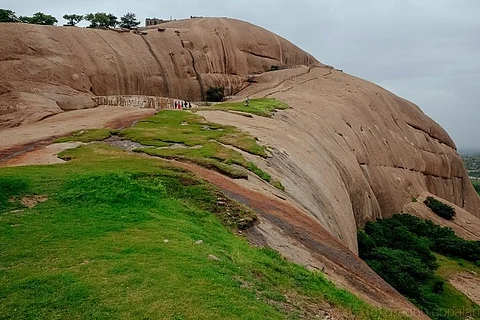

Many parts of the Deccan are peppered with gneissic granite rocks that are hundreds of millions of years old, attracting geologists from all over the world. In the town of Bhongir, at a distance of about 50kms from Hyderabad, is a huge granite batholith comparable in size to the famous World Heritage Site of Uluru in Australia.
Batholiths are massive igneous rocks that are formed when molten magma cools and solidifies, and often run kilometers deep into the earth. The one in Bhongir is shaped almost like a smooth egg, soars more than 500 feet above its surroundings, has perilous drops on all sides, and commands never-ending views of the region.
It is no surprise therefore, that a location as strategic as this has a small fort perched on top of it.


It is widely believed that the Chalukya ruler Tribhuvanamalla Vikramaditya built a simple fort here way back in the early 12th century, giving the town the name Tribhuvanagiri, which eventually became Bhuvanagiri, and finally Bhongir. The fort is also said to have been held by the Kakatiya rulers for a while.
In the middle of the 14th century, it was captured by Aladdin Hassan Bahman Shah, the first ruler of the Bahmani Sultanate which then had its capital in Gulbarga. When the Bahmani Sultanate splintered into the five Deccan Sultanates, Bhongir became a part of the Qutb Shahi Sultanate of Golconda.
A governor was stationed in the fort, and individuals who tried to usurp the Qutb Shahi throne were often imprisoned in it. Most of the present structures here date back to the Bahmani and Qutb Shahi period, and display characteristics of the architectural style favored during the era. It is rumoured that there was once a secret tunnel that went all the way from the Bhongir fort to Golconda.



The naturally impregnable fort, once surrounded by a moat for added defence, has an assortment of ruined structures all along the way to the top. The giant rock has a natural cleft which separates the fort into lower and upper regions, and the cleft is lined with many small ponds.
A beautiful dilapidated pavilion stands at the summit of the hillock, resembling the Bala Hisar Baradari, the highest structure in the Golconda Fort in Hyderabad.


At the base of the fort is a statue of Sardar Sarvai Papanna, a chieftain who is believed to have defended the fort against the rulers of Golconda for a while, but eventually lost his life. The climb to the top takes about an hour, and is most enjoyable on cooler days.
For the most part, there are steps hewn into the rock, and in the steeper stretches, there are railings to hold on to. It would be a good idea to wear shoes with a good grip, and carry drinking water along. The nearly vertical walls of the hillock are ideal for adventure sports, and Bhongir has a rock climbing school offering a variety of courses in bouldering, rock climbing and rappelling.
As forts go, the Bhongir Fort is not particularly spectacular, especially in comparison with its much grander counterparts in Golconda or Bidar. However, the beautiful drive, the geological significance of the Bhongir batholith, the exciting trek and the breathtaking views of the countryside from the top make it a wonderful day trip from Hyderabad.
All photographs by Madhumita Gopalan
Madhumita Gopalan is a photographer, blogger and history enthusiast who loves photo-documenting travel, culture and architecture. She blogs at www.madhugopalan.com
Also read: